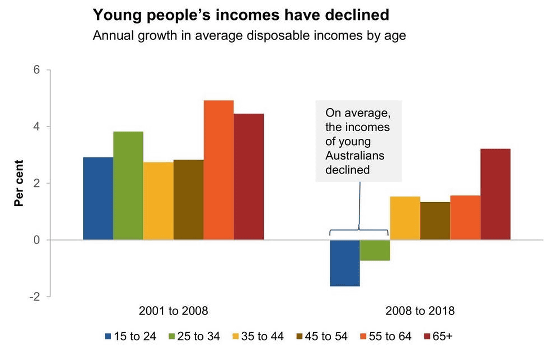Why are young people's incomes continuing to decline?

Many people around the world are facing income losses due to the effects of the novel coronavirus infection (COVID-19). However, in Australia, the Government Productivity Commission is investigating the cause of the decline in youth income before the COVID-19 epidemic.
Why Did Young People's Incomes Decline?-Productivity Commission
Why young people are earning less
https://theconversation.com/why-young-people-are-earning-less-143549

It is feared that many young people are facing financial crisis due to the new coronavirus epidemic, but there was already a problem of young people's income decline before the new coronavirus epidemic, according to the University of Melbourne. Economist Jeff Borland points out.
Below is the income growth rate for each generation from 2001 to 2008 on the left and from 2008 to 2018 on the right. The vertical axis shows the average annual growth rate of disposable income as a percentage. The blue graph is 15-24 years old, the green graph is 25-34 years old, the yellow graph is 35-44 years old, and the brown graph is 45-54 years old. , The orange graph shows 55-64 years old, and the red graph shows 65 years old and over. From 2001 to 2008, disposable income increased in all age groups, but from 2008 to 2018, the number of people aged 15 to 34 declined despite the increase in people aged 35 and over. There is.

Basically, income is divided into 'labor income', '
One of the reasons why youth's incomes have declined is the global financial crisis that began with the 2007 Lehman shock, says Catherine De Fontaney of the Australian Government Productivity Commission. The global financial crisis has intensified the labor market, lowered the starting salaries set by companies, and forced people to work part-time rather than full-time.
The combination of the two: slowing hourly wage growth and reducing part-time working hours made it difficult for young people to get a full-time job. Although the proportion of people who want to work has increased since the early 1990s, the number of jobs has started to decline due to the financial crisis, which puts young people who have just entered the labor market in a disadvantaged position. And young people who were forced into low-paying jobs early in their career were less likely to get a better job thereafter.
On the other hand, due to the increase in technology startups in recent years, some people may think that young people do their own business even if it is difficult to get hired. However, according to the Productivity Committee, while business income for young people was on the rise from 2001 to 2008, while business income for people aged 45 and older increased during 2008 to 2018, it was 45 It is said that the growth rate of business income of less than has decreased significantly. In the graphs below, the vertical axis shows the growth rate of business income, and the graphs from the left show ages 20-24, 25-34, 35-44, 45-54, 55-64, 65 and older. Light blue is 2001-2008, and blue is 2008-2018. In 2008-2018, we are experiencing a large decrease rate of -11%, especially for those aged 20-24.

Researchers believe that even after the financial crisis, even if young people earned business income, most of it came from the low-wage industry, and these changes occurred.
Learn from the experience of the global financial crisis that the youth will come to wrinkle if the labor market weakens, and support the youth financially and make it easier to start business even when the new coronavirus epidemic hits the economy Researchers think that we should go.
Related Posts:
in Note, Posted by darkhorse_log







